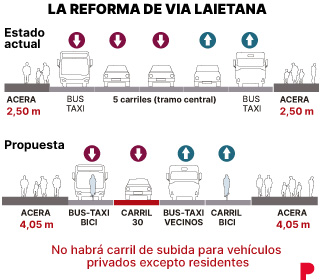November 2011. Consulted by the government team of the Mayor Xavier Triasthe RACC presents a report in which it advises against the motorcycles circulate in the bus lane, as was the wish of CiU. April 2022, the RACC studies, on its own initiative, the advisability of the bikes share space with buses and taxis on Via Laietana. In both cases, although with nuances in terms of forcefulness, a similar conclusion seems to be reached: perhaps the best thing would be for TMB and two-wheelers to go separately. The artery that connects the Eixample with the sea is in full transformation, and in order to generate sidewalks four meters wide, cyclists will have to go down the same lane as public transport. The Bicycle Club of Catalonia has already harshly criticized the measure. Now, with more moderation, they are joined by the automobile club, which more than censor designputs possible risks on the table, such as the stop time of the bus or the different speed of the vehicles.
The report has two parts: one for observation and the other for user evaluation based on 300 surveys. 27% of the cyclists interviewed do not agree with the decision to have to go down Via Laietana by one lane shared with public transport. On the other hand, 55% see it as good and 18% consider it very good. In other words, 73% seem to agree with the municipal plan.
Despite there being a some consensusthe RACC considers that it is a received measure “with a certain mistrust“. And he focuses his suspicion, among other things, on the fact that 64% of the participants in the survey say that they won’t stop behind the bus in the stop time, which will generate that look for alternatives that may put their integrity, or that of others, in danger, resorting to road dedicated to the private vehicle (36%) or going up to sidewalk (28%).
This will happen on a road where the speed is limited to 30 kilometers per hour (and it will continue to be) but the buses, as the RACC has been able to measure, frequently exceed this ceiling. In fact, all the lines (47, V15, V17 and 120) pass it at some point as they pass through this street, opened in 1908 by Alfonso XIII. The commercial speed of TMB buses, says the club, “can be conditioned by the need to share circulation space with cyclists and personal mobility vehicles (VMP)”. The same thing already happens in Creu Coberta and Sants street, according to the council, without affecting the efficiency of the public transport service. In Via Laietana, unlike this case already in practice, the bike will go downhill, allowing you to achieve a more generous pace. For all these reasons, this group gives this bike-bus-taxi road a score of 5.6.
No validation
The president of Bicycle Club of Catlaunya (Bacc), Carles Benito, already warned this newspaper about the dangers of having to pedal alongside the red TMB vehicles. Although the city council assured that the proposal for reform was born of consensusBenito denied it, assuring that “they would never” validate “a project designed so that there are accidents“. “That the bus stops on top of the bike lane -he maintains- is a fudge that blows up all the principles of cyclist safety“.

His proposal, to place public transport in the center of the road, that is, the bus and taxi lanes touching in the middle, with platforms at stopswhich would coincide with the squares and therefore there would be more width so that travelers could up and down. Going down, a 30 lane for cars and bikes on a single platform with the sidewalk, and going up, a bike lane next to pedestrians. A design, in fact, very similar to the one that has been projected in the junction of the tram by Diagonal. The final plan is a downhill lane for buses and bikes and another for cars, and uphill, a segregated cycle lane and a lane for public transport and service vehicles and neighbors.
Returning to the RACC study, in the case of VMPs, 35% of those surveyed do not want to go down the same aisle as the buses, by 65% who agree or strongly agree. And 79% are satisfied with the segregated uphill lane for bikes and scooters. As for pedestrians, 79% consider it necessary or very necessary to specific infrastructure for cyclists and VMP to prevent them from riding on the sidewalk.
The advices
Related news
In its recommendations section, the automobile club recalls that the main objective is “preserve road safety of the different user profiles of the new lane”. It is surprising, however, that it does not explicitly claim separate bikes and buses as he did in 2011 when he got the idea of the road-bus-motorcycle out of Trias’s head. The RACC recommends information campaigns to remember that the artery is a pacified waycontrol the speed of vehicles, raise awareness among TMB drivers of the risks of sharing space with bicycles, design crossings well to avoid shocks and include signaling to ensure compliance with regulations.
Beyond the bus-bike lane, the RACC’s position on the reform of Via Laietana was already made clear at the beginning of April when the entity’s president, Joseph Mateuwarned that the traffic will move to other places, causing nuisance to neighbors of the receiving streets of this traffic, such as Paral·lel or Paseo de Picasso. If everything goes according to plan, the first phase (Urquinaona-Antonio Maura) will be finished in the first quarter of 2023. The second, up to Isabel II/Colón, is left for the next term.